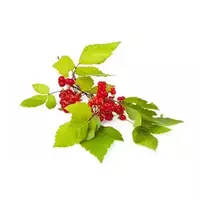Stone bramble

The drupe is a perennial honey plant that belongs to the pink family. In height, it can reach 30 centimeters, and long open shoots up to one and a half meters long creep along the ground. Small drupe flowers are colored white and collected in corymbose inflorescences at the apex of the stem of 3-10 pieces.
The bone fruit is a fairly large collection of orange or bright red bones, which, as a rule, consists of four miniature fruits, each containing a large bone. Mature drupe berries are said to taste like pomegranates.
The bone is found mainly in mixed and coniferous forests, on clearing, edges, steppe meadows, as well as among shrubs. This plant can most often be found in the central regions of our country, central Europe, North America and Asia, in the Caucasus, as well as in Eastern and Western Siberia.
In cooking, fresh bone berries are mainly consumed as dessert in sugar, milk, cream or natural honey. In addition, you can cook delicious jelly, jelly, jam, syrups from it, cook juices, kvass, fruit drinks and mousses. The special properties of the bone allow many culinary experts to make vinegar, wine, tea and a coffee drink based on it.
By the way, tea from the leaves of the bone is distinguished by an extraordinary aroma, reddish-brown color and a little astringent, but from this no less pleasant taste. For long-term storage, it is recommended to sprinkle the berries with sugar, but it is better, if possible, to use the bone fresh.
The benefits of the bone
The benefits of the bone are contained in this berry: flavonoids, phytoncides, pectin substances, sugars, tocopherol and a large amount of vitamin C are found in it. In official medicine, this useful berry is not used, while folk has a considerable number of different ways to use the healing properties of the bone.
For example, in Siberia, an infusion based on the leaves of this plant is used as a natural painkiller for heart ailments and migraines. Bone preparations are known to have diuretic, sweating, anti-inflammatory and antimicrobial effects. In addition, the decoction of stems and leaves of the bone helps with diseases of the gastrointestinal tract, inflammation of the joints, tumors and gout.
The high content of ascorbic acid allows the use of bone berries for colds and malblood, as well as for the prevention and therapy of vitamin deficiency. The benefits of the bone, in particular its juice, are especially relevant for people who take care of the healthy state of their body - regular consumption of this wonderful drink contributes to the strengthening of the walls of blood vessels, as well as the natural disposal of toxins and harmful cholesterol.
drupes 40 kKal
Energy value of the bone (Ratio of proteins, fats, carbohydrates - ju):
Proteins: 0.8 g (~ 3 kCal)
Fats: 0.9 g (~ 8 kCal)
Carbohydrates: 7.4 g (~ 30 kCal)
Energy ratio (b | y): 8% | 20% | 74%
 Español
Español Français
Français Português
Português Русский
Русский 简体中文
简体中文 繁體中文
繁體中文 日本語
日本語 한국어
한국어 العربية
العربية Türkçe
Türkçe Қазақ
Қазақ Deutsch
Deutsch Italiano
Italiano Українська
Українська
